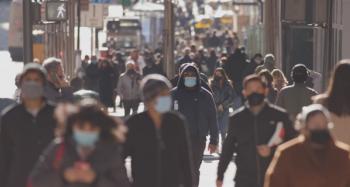
COVID-19 Pandemic May Have Led to a Reduction in Skin Cancer Screening Access
A study indicates that possible disruptions in skin cancer screenings and general dermatologic care at the time of the pandemic could have resulted in fewer diagnoses of melanoma generally.
The COVID-19 pandemic led to a notable decline in early-stage and less aggressive melanomas such as superficial spreading melanomas, according to new findings, and the fact that these are often associated with screening potentially reflects reduced access to skin cancer screening and dermatologic care at the time of the pandemic.1
These findings and more came from new research conducted to address the multiple recent studies which have suggested a greater relative number of advanced melanoma cases in the US at the time of the COVID-19 pandemic but also neglected to examine incidence of melanomas.2
The new research letter assessing incidence of melanomas was led by Daniel Y. Kim, BS, from the Department of Dermatology at Brigham and Women’s Hospital, Boston, Massachusetts.
“To address this gap, we used data from the Surveillance, Epidemiology, and End Results (SEER) program to examine melanoma incidence changes during the pandemic,” Kim and colleagues wrote.
Background and Findings
The investigators used data drawn from 17 SEER registries, and they identified 76,846 newly-confirmed cases of first primary in situ or invasive cutaneous melanoma that had been given a diagnosis in the time frame between January 2018 and December 2020.
The research team computed the annual rates of incidence per 100,000 person-years, adjusting for age according to the 2000 standard population while stratifying by disease stage and several different demographic and pathological elements. They analyzed ethnicity as well as racial data to find which had been the most impacted groups at the time of the COVID-19 pandemic.
As they assessed these elements, they calculated the percentage changes in rates of incidence between the years 2018 and 2019, and they also calculated these same numbers between the years 2019 and 2020. Brigham and Women's Hospital granted exemption from review and waived informed consent requirements due to the use of deidentified data, and adherence to the STROBE reporting guideline was maintained throughout.
Each of the statistical tests by the research team were 2-sided, and the team used the Bonferroni method for various different corrections to hypotheses with an α level of .0008. The analyses were carried out in April of 2023.
In the year 2020, the investigators reported substantial reductions in both in situ and invasive melanoma diagnoses, especially with regard to older, male, and non-Hispanic White individuals. Specifically, compared to 2019, in 2020 there were major declines (PC, -24.52%; 95% CI, -26.56% to -22.42%).
These declines most were shown to have impacted older individuals (PC, -27.51%; 95% CI, -30.17% to -24.76%), men (PC, -26.40%; 95% CI, -29.08% to -23.61%), and non-Hispanic White individuals (PC, -23.35%; 95% CI, -25.53% to -21.10%). Interestingly, they also found that rates of incidence regarding superficial spreading melanomas, which are linked to melanoma screening, substantially diminished at the time of the pandemic, though acral lentiginous melanoma rates were shown to have been stable.
The noted decreases were found by the research team to have been most apparent among those with early-stage as well as less aggressive types of melanoma. In fact, the incidence of stage I melanomas was shown by the team to have decreased in 2020 compared to the lack of change between 2018 and 2019, while other stages remained relatively stable (PC, -22.26%; 95% CI, -24.62% to -19.83%).
Overall, the team’s results indicate possible disruptions in skin cancer screenings and general dermatologic care at the time of the pandemic may have resulted in fewer diagnoses of melanoma generally.
The investigators did acknowledge, however, that the research did have certain limitations, one of which was its reliance on potentially underreported data aon melanomas. Another may have been the study’s attention to specific 2020 data, with subsequent changes in incidence being unknown.
“This study adds to the current literature by highlighting that the relative increase in thick melanomas in 2020 was primarily associated with a marked decrease in thin melanomas, rather than an absolute increase in thicker melanomas,” they wrote.
References
1. Kim DY, Hartman RI. Incidence of In Situ and Invasive Cutaneous Melanomas During the COVID-19 Pandemic in the US. JAMA Dermatol. Published online September 06, 2023. doi:10.1001/jamadermatol.2023.2712.
2. Kim DY, Behbahani S, Hartman RI. Impact of COVID-19 pandemic on melanoma presentation by facility type and region in the United States. J Am Acad Dermatol. 2023;89(1):175-178.
Newsletter
Pharmacy practice is always changing. Stay ahead of the curve with the Drug Topics newsletter and get the latest drug information, industry trends, and patient care tips.
























































































































